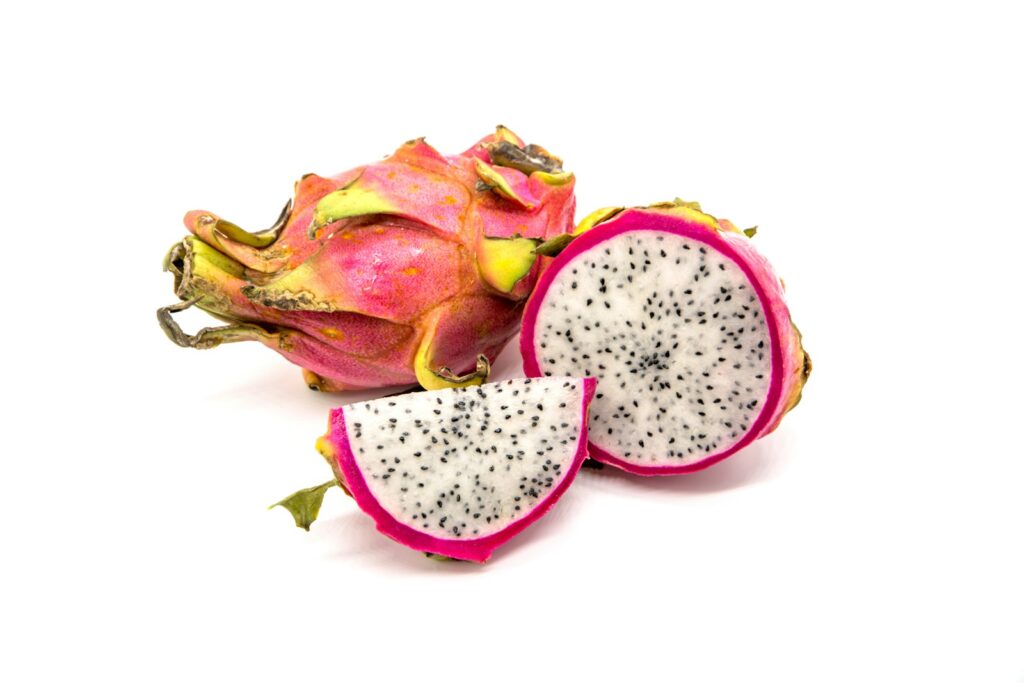12 Facts About Dragonfruit (Pitaya)

Introduction
Dragonfruit, also known as pitaya or strawberry pear, is the fruit of a night-blooming cactus species called Hylocereus. While dragonfruit is believed to be native to southern Mexico and Central America, it is now grown commercially in several tropical regions across the globe. Vietnam, Nicaragua, Colombia, Israel, and China lead the world in dragonfruit production today.
While it may look intimidating with its pinkish-red skin and green, scaly protrusions, dragonfruit offers an exceptionally sweet, kiwi-pear flavor and a range of nutritional benefits. Read on to learn more about this incredible superfood.
Facts About Dragonfruit

- Dragonfruit comes in three main varieties – white flesh with pink skin, red flesh with pink skin, and white flesh with yellow skin. The most commonly exported variety globally is the white-fleshed pink-skinned dragonfruit.
- Dragonfruit is low in calories but packed with nutrients – One cup of dragonfruit contains only 60 calories but is loaded with vitamin C, magnesium, iron, and fiber. Dragonfruit is also high in antioxidants called betacyanins.
- The skin and seeds of dragonfruit are edible – While some people prefer to scoop out the interior flesh, both the skin and nutty seeds can be safely consumed. Eating the whole fruit maximizes nutrition.
- Dragonfruit may help fight chronic diseases – Studies indicate components in dragonfruit may help lower blood sugar, reduce heart disease risk factors, fight colon cancer, and even inhibit the growth of leukemia cells. These benefits likely come from its supply of antioxidants.
- Dragonfruit can boost your immune system – Rich in vitamin C, dragonfruit helps stimulate the production of white blood cells needed to fight infection. Just one cup contains 14% of your daily vitamin C needs.
- Dragonfruit contains prebiotic fiber to feed good gut bacteria – In addition to regular fiber that promotes good digestion, dragonfruit contains prebiotic carbohydrates that specifically nourish the beneficial bacteria in your intestines.
- Dragonfruit plants can produce fruit for 20-30 years – The climbing cacti that bear dragonfruit are resilient plants that continue producing fruit each year without much need for replanting compared to other crops.
- Dragonfruit flowers only bloom at night – The large, aromatic dragonfruit flowers open after sunset to attract pollinators and close by morning. The flowers only last about one night before wilting.
- Dragonfruit is versatile in the kitchen – From smoothie bowls to sorbets and salad topping, dragonfruit can be sliced raw or blended to create sweet and savory dishes. Its mild sweetness pairs nicely with other fruits and vegetables.
- Vietnam leads the world in dragonfruit exports – Accounting for over 50% of global dragonfruit exports, Vietnam ships thousands of tons annually to markets like the United States, Europe, China and Southeast Asia.
- Dragonfruit may get its name from its mythical appearance – With a pinkish-red skin and green, leafy spikes, dragonfruit is said to resemble a dragon, leading to its exotic common name around the world.
- Climate change threatens future dragonfruit production – As a tropical crop, dragonfruit growth could be limited by rising temperatures and extreme weather conditions resulting from climate change in coming decades.
Conclusion
With its alluring pink and green exterior, mildly sweet white flesh, and stellar nutrient profile, dragonfruit is truly a magnificent superfood. Offering a multitude of health and nutritional benefits from fiber and antioxidants to infection-fighting vitamin C, dragonfruit deserves a spot in your diet. Though exotic and mysterious in appearance, dragonfruit is reasonably priced, simple to prepare, and can be enjoyed as part of smoothies, salads, sorbets, and more. So do your body a favor and bite into this incredible superfruit. Your tastebuds and your health with both thank you.

FAQ about Pitaya (Dragon Fruit)
What is a pitaya?.
A pitaya, also known as dragon fruit, is the fruit of several cactus species, primarily of the genus Stenocereus and Selenicereus. It’s recognized for its unique look, featuring a leathery skin with scaly spikes
Where does pitaya come from?
Pitaya is indigenous to southern Mexico and parts of Central America. It is now widely cultivated in various regions including East Asia, Southeast Asia, the United States, the Caribbean, Australia, and tropical and subtropical areas around the globe.
Are there different types of pitaya?
Yes, there are different varieties of pitaya. The sour types typically belong to the genus Stenocereus, while sweet varieties, often referred to as dragon fruit, are from the genus Selenicereus. The sweet varieties can have white, red, or yellow flesh.
How is pitaya cultivated?
Pitaya seeds are planted in compost or potting soil and can grow as indoor plants. They require careful watering to prevent overwatering. Commercially, they are planted densely and can take up to five years to reach full production, with ideal temperatures ranging from warm to hot climates.
What are the nutritional benefits of pitaya?
Pitaya is low in calories but rich in carbohydrates, dietary fibers, and vitamins such as Vitamin C and Vitamin K. It also contains minerals like calcium, iron, magnesium, phosphorus, and potassium. It’s especially recognized for its water content and antioxidants.





